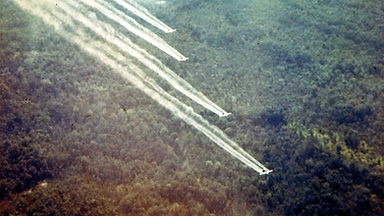Cambodia
While almost all of the 20 million gallons of herbicides were sprayed in southern Vietnam, the U.S. war effort spilled over into avowedly neutral Cambodia. Little is known about the extent of the spraying and its present-day impacts on the environment and the people living in these sprayed areas.



A Brief History of U.S. Spraying in Cambodia
Unlike Laos, Cambodia was not systematically sprayed, though the HERBS database does show records of spray runs conducted in Cambodian territory. Yet the damage done to Cambodia indicates more than occasional or mistaken spraying. It is likely that over 1 million gallons of herbicide sprayed on the Ho Chi Minh trail in South Vietnam drifted to settle on Cambodia. Between April 18 and May 2, 1969, about 270 square miles of French and Cambodian rubber plantations in Kampong Cham Province were sprayed. Gardens and trees in nearby villages were also impacted, including 45,000 jackfruit trees that were either completely destroyed or severely damaged. The damage to these areas in Kampong Cham province (or what is now Tbong Khmum province) was too far from the border and too extensive to be caused by spray drift.
It was unclear exactly the entity or forces that carried out the spraying over the plantations; it was purported at the time that the spraying missions, flown by Air America aircraft, were led by the Central Intelligence Agency. In 1969, the Cambodian government filed a claim for $12.2 million in damages, though the U.S. there was never any admission of responsibility by the U.S. Ultimately, however, The U.S. ultimately agreed to pay the claim by 1972, in order to promote “broader interests.”
Anecdotal reports from residents of Mondulkiri and Ratanakiri provinces in northeast Cambodia, though unsubstantiated, have alleged that herbicides were sprayed in these regions as well, during the war. More research is needed to confirm these reports, as well as the reports of spraying in the Prey Veng and Svay Rieng in southern Cambodia.
